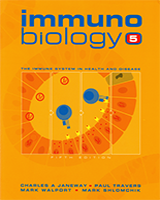From: B-cell activation by armed helper T cells

NCBI Bookshelf. A service of the National Library of Medicine, National Institutes of Health.

Multiple cross-linking of the B-cell receptor by TI-2 antigens can lead to IgM antibody production (left panels), but there is evidence that helper T cells greatly augment these responses and lead to isotype switching as well (right panels). It is not clear how T cells are activated in this case, because polysaccharide antigens cannot produce peptide fragments that might be recognized by T cells on the B-cell surface. One possibility is that a component of the antigen binds to a cell-surface molecule common to all helper T cells, as shown in the figure. Another possibility (not shown) is that certain γ:δ T cells or CD4 CD8 double-negative α:β T cells can provide help, as some of these cells have T-cell receptors that recognize certain polysaccharrides bound to unconventional MHC molecules such as CD1.
From: B-cell activation by armed helper T cells

NCBI Bookshelf. A service of the National Library of Medicine, National Institutes of Health.